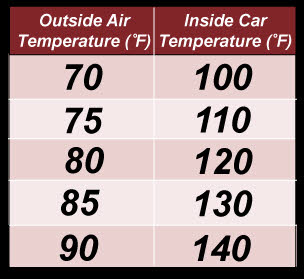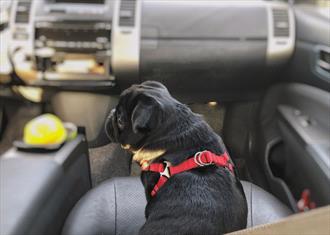Temperature in car chart

Graphic by VIN
I have a bit of a confession to make.
When I was a teenager, our family accidentally killed our dog.
She was a sweet, old pug, named after a girl I had a crush on in kindergarten – Betsy – and she deserved better.
When it was time for my family to drive me to college, a trip from Baltimore to Seattle, we stopped at SeaWorld of Ohio. We made the dreadful decision to leave her in the car, and since it was a mild day in September, we thought no harm would come of it. We were dead wrong.
I don’t recall that day at SeaWorld or how long we were there. Probably hours. I do remember getting back to the car with my mom and my grandmother and seeing that something was very wrong. I remember cradling Betsy’s head as she turned purple and made guttural, rasping noises as she tried to breathe through her heat-ravaged airways. Noises I’ll never forget, noises no dog owner should ever have to hear, nor any dog ever have to suffer through.
I remember a frantic search for a veterinarian somewhere in Ohio and the slow, sad shake of the technician’s head as she took Betsy’s limp body from me. Whether that shake was her way of letting me know Betsy was dead, or if it was her rebuke for yet another needless heatstroke death, I’ll never know.
We were idiots and we killed our dog.
Does this have any bearing on my later becoming an ER vet, and treating heatstroke cases? I like to think so.
I’m not a big believer in karma, but hopefully by treating cases like Betsy’s, and by raising awareness about heatstroke and its prevention, I’m somehow making up for our error 35 years ago in some cosmic way.
I’m sorry, Betsy.
With that rather sad introduction, let’s go over what heatstroke is, how to prevent it, and what can be done to treat it.
Let’s start with the most basic point of all: a cracked window or two is not enough to prevent heatstroke when it’s hot, or even warm. It’s also not enough to park in the shade on a hot day and leave all the windows and even the sunroof open. This concept that a bit of air is enough has led to untold tragedy.
Along with blood pressure, blood sugar and a host of other important things, body temperature is closely regulated within a narrow range by the brain and nervous system. If the body becomes too hot, the brain recognizes this and takes measures to dump the excess heat into the universe. For us, this means sweating, where the heat lost through evaporation helps to move energy from the body to the universe.
The brain also sends signals to move to a cooler place: shade, a nice cave, indoors, etc.
Dogs can’t really sweat (a bit through the footpads, that’s it) so instead, they pant. Panting increases evaporation from the tongue, which, similar to sweating, takes energy from the evaporation of water and sends it out to the universe. The universe is big, so it can handle it.
If, for some reason, heat can’t be moved out of the body, bad things happen. The reason that the brain, nervous system and all of those other systems work so hard to keep body temperature normal is basically because all living things are big bags of chemicals and proteins reacting together, and those reactions can be specific about how they function. Jack up the temp a few degrees and they start to rebel, or worse.
Let’s look at proteins: You’ve seen an egg white go from snotty, viscous fluid to a nearly solid, cooked white. The same reaction happens to proteins in the body when the temp goes up. And proteins in the body do everything: Proteins keep your blood from clotting as it’s pumped around; proteins keep your blood sugar normal and your organs organized.
So, a patient suffering from heatstroke is almost literally cooked.
If the body temp goes high enough for long enough, every organ, every tissue is affected. If the damage is widespread enough, the patient will die, like our unfortunate Betsy.
Pug in car

Photo courtesy of Depositphoto
How long is too long? How high is too high? I hate to say it, but it depends. I’ve seen dogs come in at 112°F that do just fine, and I’ve seen dogs succumb to heat stroke that had a normal temp by the time they got to me. (Normal dog body temp is about 101-102°F.)
Lots of factors come into play, such as breed, their general health before heatstroke, environment, measures to take down temp, etc. A dog that’s had heatstroke once is always going to be at risk, since one of the functions that’s affected by high body temperatures is the brain’s heat-sensor system. It gets shorted out by the high heat and is less likely to send signals to pant and get out of the heat the next time the temp goes up. It’s like a cruel joke.
Betsy was a pug, a member of a family of dogs called brachycephalics, which means “short head.” Since their noses and upper airways are so short, they can’t exchange heat the way dogs with longer snouts can. Bulldogs and Pekingese are also brachycephalic, and any dog of this body type is extremely sensitive to heatstroke. If I see a bulldog out on a sunny day, I worry.
Betsy simply was not able to dump heat back into the universe because she couldn’t pant effectively. The harder she tried, the more swollen her tiny airway became, and the more heat she herself generated in trying to breathe, making things worse. It is a spiral of death.
Her universe was also much smaller since she was locked in a Volvo. Any heat she managed to dump off just came right back to her, with more coming in the windows every minute. And she couldn’t get away from it.
So, how do we manage heatstroke patients in the ER? The first priority, of course, is to bring the body temp back to normal. Sometimes we get creative with this, placing cooled fluids in the abdominal cavity or colon. External cooling, with fans, ice baths, a chilled stainless table, etc., can also help.
That’s only half the battle, though. If the heat has already done its damage, we have to assess the degree of injury and help support the body through it. There’s no magic bullet, we just need to be vigilant and see what organ systems raise their hand and ask for help. Kidneys, brain, blood clotting ability – all are quite susceptible to heat-induced injury, so blood products and IV fluids are commonly needed to get everything back in order if we can. If the kidneys shut down or blood starts clotting when it’s supposed to be circulating, it’s not often a fight we win.
Now that we’ve seen just what horrors heat stroke can inflict on that big bag of proteins and chemicals, let’s talk about where you come in: prevention and what you can do if your dog overheats.
Prevention should be easy: don’t make my mistake and leave your dog in the car. Even on a cool day, your car can absorb enough energy to turn into a death mobile in just a few minutes. Sadly, thousands of people still make the same mistake my family did in September 1985 and leave their dogs in the car. It’s gotten better; folks are more aware, and cities even have Good Samaritan laws allowing people to bust dogs out of cars without fear of prosecution, but there’s still work to be done.
The outdoors has its own set of risks as well. Make sure your dog has shade and water, and if it’s really hot and humid, get them indoors and air-conditioned. Also, don’t exercise your dog on a hot day as they often will keep going and playing long past the point that they should stop and cool off.
If you own a bulldog or other brachycephalic, stay cool. Literally. Even a walk can turn lethal. It’s almost bad enough that I think brachycephalics should be indoors only while the sun shines from February to October.
Listen to your dog. If they’re panting, especially panting noisily, it’s time to cool off. And if it’s too hot for you, it’s probably too hot for your dog.
If you think your dog is suffering from heatstroke, here are a few things to do:
- Stop playing/walking immediately and get them in the shade.
- If there’s no vomiting and they are conscious, offer cool water to drink.
- Run the A/C in the car (on the way to the vet) on high.
- If they are severely affected, dunk them in the coldest water you can find. There used to be an old wives’ tale about not using ice water, but that’s been debunked. Ice away.
- Don’t cover the dog in a wet towel as that can insulate and keep heat in. Cold running water or an ice bath are best.
- Make sure they have shade and fresh water if left outside.
- Most importantly: Head to the vet as fast as you legally/safely can.
Please don’t let Betsy’s death be in vain. Heatstroke kills, but it’s eminently preventable.